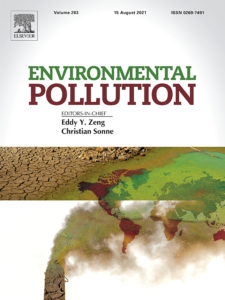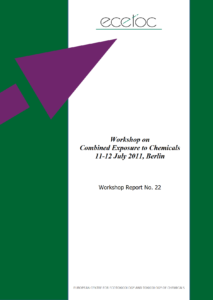2011
Hodges, J. (Unilever); Holmes, C.M. (Waterborne Environmental, Inc); Vamshi, R. (Waterborne Environmental, Inc); Price, O. (Unilever)
Estimating Chemical Emissions from Home and Personal Care Products in China Journal Article
In: Environmental Pollution, vol. 165, pp. 199-207, 2011.
Abstract | Links | Tags: 2011, Peer-Reviewed Publication
@article{2011ChemEmiss,
title = {Estimating Chemical Emissions from Home and Personal Care Products in China},
author = {Hodges, J. (Unilever) and Holmes, C.M. (Waterborne Environmental, Inc) and Vamshi, R. (Waterborne Environmental, Inc) and Price, O. (Unilever)},
url = {https://www.sciencedirect.com/science/article/abs/pii/S0269749111006269?via%3Dihub, View Online},
doi = {https://doi.org/10.1016/j.envpol.2011.11.009},
year = {2011},
date = {2011-11-08},
urldate = {2011-11-08},
journal = {Environmental Pollution},
volume = {165},
pages = {199-207},
abstract = {China's economy has grown significantly and concomitantly so has the demand for home and personal care (HPC) products. The detection of chemicals used in HPC products is increasing in profile as China strives to improve its environmental management. China is developing robust exposure models for use in regulatory risk-based assessments of chemicals, including those chemicals used in HPC products. Accurate estimates of chemical emissions play an important role within this. A methodology is presented to derive spatially refined emissions from demographic and economic indicators with large variations in emissions calculated, showing product usage being higher in East and South China. The less affordable a product, the greater the influence per capita Gross Domestic Product has on the product distribution. Lastly, more spatially resolved input data highlights greater variation of product use. Linking product sales data with population density increased the observed variability in absolute usage distribution of HPC products at the county > province > regional > country scale.},
keywords = {2011, Peer-Reviewed Publication},
pubstate = {published},
tppubtype = {article}
}
China's economy has grown significantly and concomitantly so has the demand for home and personal care (HPC) products. The detection of chemicals used in HPC products is increasing in profile as China strives to improve its environmental management. China is developing robust exposure models for use in regulatory risk-based assessments of chemicals, including those chemicals used in HPC products. Accurate estimates of chemical emissions play an important role within this. A methodology is presented to derive spatially refined emissions from demographic and economic indicators with large variations in emissions calculated, showing product usage being higher in East and South China. The less affordable a product, the greater the influence per capita Gross Domestic Product has on the product distribution. Lastly, more spatially resolved input data highlights greater variation of product use. Linking product sales data with population density increased the observed variability in absolute usage distribution of HPC products at the county > province > regional > country scale.
Exposure in the aquatic environment. ECETOC Workshop: Combined Exposure to Chemicals. Technical Report
no. Workshop Report No. 22, 2011, ISSN: 2078-7219-22.
Abstract | Links | Tags: 2011, ECETOC, Public Report
@techreport{2011EcetocExposure,
title = {Exposure in the aquatic environment. ECETOC Workshop: Combined Exposure to Chemicals.},
url = {https://www.ecetoc.org/publication/workshop-report-22-workshop-on-combined-exposure-to-chemicals/, Workshop Page
https://www.ecetoc.org/wp-content/uploads/2014/08/ECETOC_WR_22._Combined_exposure_to_chemicals.pdf, Workshop Slides},
issn = {2078-7219-22},
year = {2011},
date = {2011-07-11},
urldate = {2011-07-11},
number = {Workshop Report No. 22},
abstract = {In the last 10 years, there has been a significant amount of research into the toxicology of mixtures and co-exposure, which has genuinely increased our understanding. Participants at the workshop generally agreed that the WHO/IPCS framework provides a useful tool for risk assessment of combined exposure to multiple chemicals from multiple sources. A suitable problem formulation at the outset of any risk assessment of combined exposures to multiple chemicals was thought to be a fundamental first step.
There was overall recognition that according to available evidence, in practice, the toxicity of mixtures in the environment is often dominated by a few of their components, and that these can be identified by available approaches. In this regard, where relevant data are available, the Maximum Cumulative Ratio approach is a useful tool for both human health and environmental risk assessments.
The current state of knowledge shows that synergy (exceeding additive effects) is rare and appears to be toxicologically significant only at doses at which there is significant toxicity of one or more of the individual components in the combination. The available data indicate that synergy does not normally occur at environmental concentrations of man-made chemicals. For chemicals that have different modes of action, there is currently very little data to support the occurrence of combination effects below their individual predicted no-effect levels. However, in the absence of information on mode of action, dose / concentration addition can be used as the conservative default.
The discussion at the workshop identified a number of areas that require further research, such as better understanding of mode of action, improved methodologies of exposure assessment including assimilation of better databases and data processing methods. The threshold of toxicological concern approach and non-testing methods were suggested as potentially useful tools that also need further development for use in this context.
In recent years, there has been growing public perception and concern about the possibility of “cocktail effects” of chemicals at very low doses of the single substances (i.e. below levels deemed to be safe for humans and the environment) which are generally not taken into account in regulatory risk assessment. The current evidence offers little support for this; although some of the workshop participants were of the opinion that the current knowledge on combined exposure and effects was too limited to allow such a conclusion. It is important that combined exposures be considered in risk assessment practice – through the use of science-based, targeted and pragmatic tiered approaches. Such approaches should allow identification of any combinations which may require priority attention.
Whilst recognising the importance of addressing the potential risk of combined exposures to chemicals, this should perhaps be seen in light of the various other scientific areas that are important for protecting and improving human health and the environment. However, some workshop participants felt that this view is a general one, which does not only concern the issue of combined exposure and effects of chemicals. Overall though, the use of a tiered approach is strongly recommended to ensure optimum use of resources.},
keywords = {2011, ECETOC, Public Report},
pubstate = {published},
tppubtype = {techreport}
}
In the last 10 years, there has been a significant amount of research into the toxicology of mixtures and co-exposure, which has genuinely increased our understanding. Participants at the workshop generally agreed that the WHO/IPCS framework provides a useful tool for risk assessment of combined exposure to multiple chemicals from multiple sources. A suitable problem formulation at the outset of any risk assessment of combined exposures to multiple chemicals was thought to be a fundamental first step.
There was overall recognition that according to available evidence, in practice, the toxicity of mixtures in the environment is often dominated by a few of their components, and that these can be identified by available approaches. In this regard, where relevant data are available, the Maximum Cumulative Ratio approach is a useful tool for both human health and environmental risk assessments.
The current state of knowledge shows that synergy (exceeding additive effects) is rare and appears to be toxicologically significant only at doses at which there is significant toxicity of one or more of the individual components in the combination. The available data indicate that synergy does not normally occur at environmental concentrations of man-made chemicals. For chemicals that have different modes of action, there is currently very little data to support the occurrence of combination effects below their individual predicted no-effect levels. However, in the absence of information on mode of action, dose / concentration addition can be used as the conservative default.
The discussion at the workshop identified a number of areas that require further research, such as better understanding of mode of action, improved methodologies of exposure assessment including assimilation of better databases and data processing methods. The threshold of toxicological concern approach and non-testing methods were suggested as potentially useful tools that also need further development for use in this context.
In recent years, there has been growing public perception and concern about the possibility of “cocktail effects” of chemicals at very low doses of the single substances (i.e. below levels deemed to be safe for humans and the environment) which are generally not taken into account in regulatory risk assessment. The current evidence offers little support for this; although some of the workshop participants were of the opinion that the current knowledge on combined exposure and effects was too limited to allow such a conclusion. It is important that combined exposures be considered in risk assessment practice – through the use of science-based, targeted and pragmatic tiered approaches. Such approaches should allow identification of any combinations which may require priority attention.
Whilst recognising the importance of addressing the potential risk of combined exposures to chemicals, this should perhaps be seen in light of the various other scientific areas that are important for protecting and improving human health and the environment. However, some workshop participants felt that this view is a general one, which does not only concern the issue of combined exposure and effects of chemicals. Overall though, the use of a tiered approach is strongly recommended to ensure optimum use of resources.
There was overall recognition that according to available evidence, in practice, the toxicity of mixtures in the environment is often dominated by a few of their components, and that these can be identified by available approaches. In this regard, where relevant data are available, the Maximum Cumulative Ratio approach is a useful tool for both human health and environmental risk assessments.
The current state of knowledge shows that synergy (exceeding additive effects) is rare and appears to be toxicologically significant only at doses at which there is significant toxicity of one or more of the individual components in the combination. The available data indicate that synergy does not normally occur at environmental concentrations of man-made chemicals. For chemicals that have different modes of action, there is currently very little data to support the occurrence of combination effects below their individual predicted no-effect levels. However, in the absence of information on mode of action, dose / concentration addition can be used as the conservative default.
The discussion at the workshop identified a number of areas that require further research, such as better understanding of mode of action, improved methodologies of exposure assessment including assimilation of better databases and data processing methods. The threshold of toxicological concern approach and non-testing methods were suggested as potentially useful tools that also need further development for use in this context.
In recent years, there has been growing public perception and concern about the possibility of “cocktail effects” of chemicals at very low doses of the single substances (i.e. below levels deemed to be safe for humans and the environment) which are generally not taken into account in regulatory risk assessment. The current evidence offers little support for this; although some of the workshop participants were of the opinion that the current knowledge on combined exposure and effects was too limited to allow such a conclusion. It is important that combined exposures be considered in risk assessment practice – through the use of science-based, targeted and pragmatic tiered approaches. Such approaches should allow identification of any combinations which may require priority attention.
Whilst recognising the importance of addressing the potential risk of combined exposures to chemicals, this should perhaps be seen in light of the various other scientific areas that are important for protecting and improving human health and the environment. However, some workshop participants felt that this view is a general one, which does not only concern the issue of combined exposure and effects of chemicals. Overall though, the use of a tiered approach is strongly recommended to ensure optimum use of resources.


